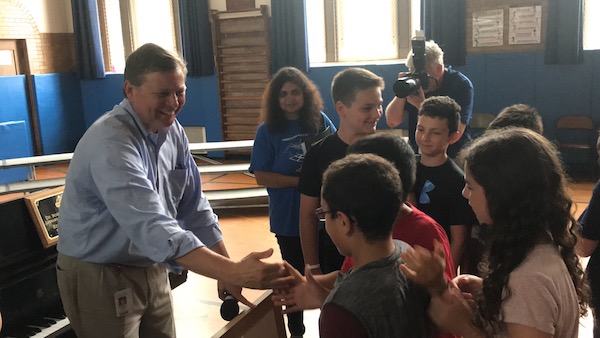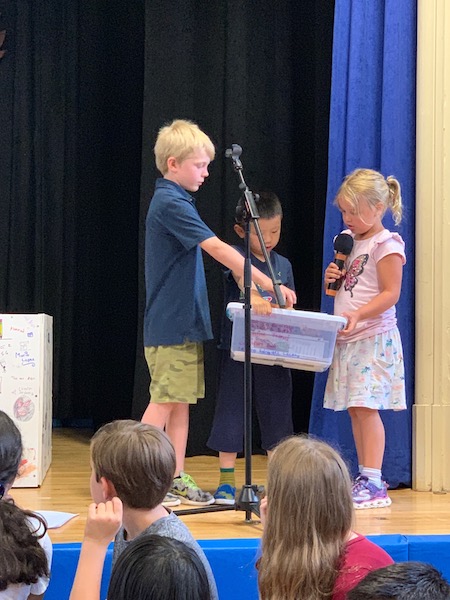Edgewood Says Goodbye to Dr. Houseknecht and Completes Cenetennial Celebration
- Details
- Written by: Joanne Wallenstein
- Hits: 5089
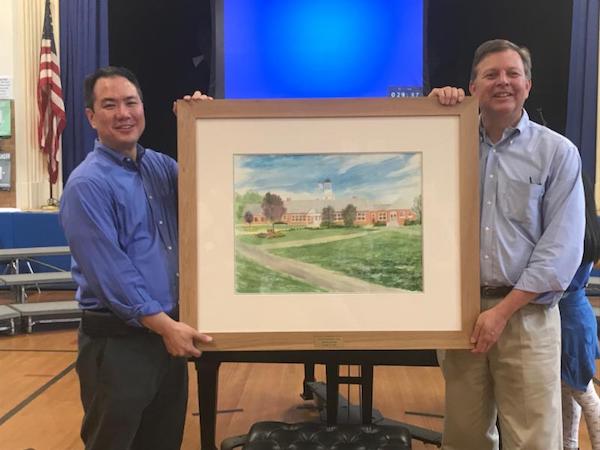 Edgewood Elementary School students, teachers and parents gathered on June 25 for the final assembly of their centennial year to remember 2018-19 and say goodbye to Principal Scott Houseknecht who retires after almost 30 years at the school.
Edgewood Elementary School students, teachers and parents gathered on June 25 for the final assembly of their centennial year to remember 2018-19 and say goodbye to Principal Scott Houseknecht who retires after almost 30 years at the school.
They sung the school song and looked back on a special year that included a talent show, the opening of the new Edgewood Library, a night at Citi Field, the unveiling of the time capsule, Edgewood Academy, a festive gala and much more. Assistant Principal Mr. Yang put together a slide presentation highlighting a year of events and celebrations at the school. Each class had the chance to contribute some mementos to the time capsule and a book of well wishes by the children was presented to Dr. Houseknecht.
Yang also arranged for aerial photography of the students in the school arranged to communicate a few parting messages – which you can see here.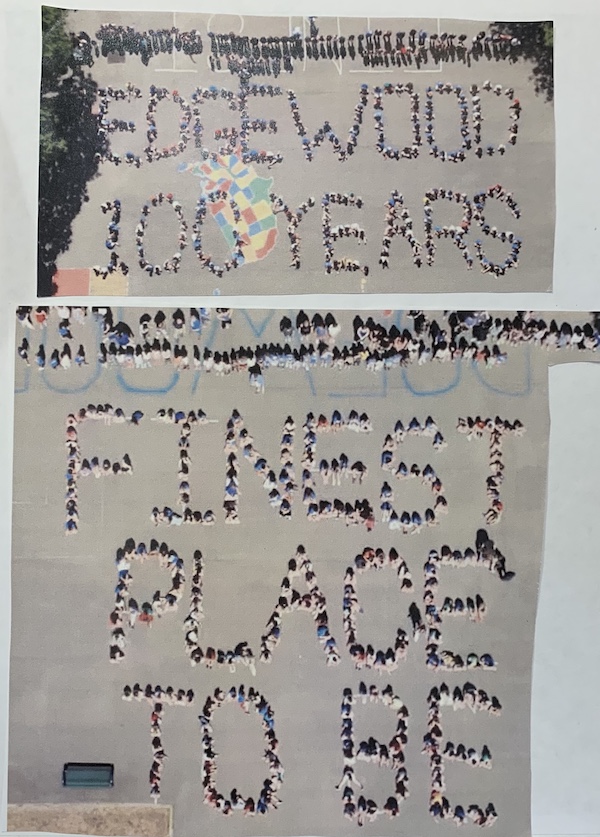
Dr. Houseknecht will forever be rememberd at Edgewood as the new library and media center was named the Dr. Scott Houseknecht Library and Media Center.
Finally, the PTA presented this beautiful watercolor of Edgewood School, painted by Mike Teatoro to be displayed at the school.
Presenting the watercolor, PTA co-Presidents Susie Smith and Heedan Chung-Goh said,:
Dr. Scott Houseknecht, thank you for being our principal for close to 3 decades. During your tenure at Edgewood School, our children greatly benefited from your leadership in driving innovative educational practices within our building. Through your interest in teaching the history of our school, and cultivation of old and new traditions, you have nurtured in our children a sense of identity and place as citizens of not just Edgewood, but of greater Scarsdale. You have ensured that Edgewood is the finest place to be, a place of learning, caring, and belonging.
In your honor, the Edgewood School PTA is gifting a watercolor of the school.
This watercolor painting by Mike Teator is in special recognition of Edgewood School’s one hundred years of rich history for which the school has grown from a twelve-room schoolhouse in 1919 to the one we have today seen in this painting in 2019. In honor of our Centennial celebration, the Edgewood PTA lovingly dedicate this painting today, June 25, 2019 to the school and to Dr. Scott Houseknecht, Edgewood’s sixth principal from 1990-2019, who oversaw the growth of not only the construction of the building but also the hearts and minds of students.
Proposal to Install Lights at Butler Field Referred to Village Planning Board
- Details
- Written by: Joanne Wallenstein
- Hits: 7827
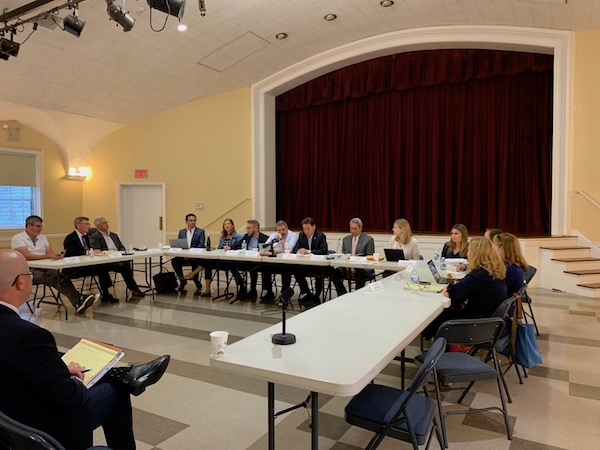 A joint meeting of the Scarsdale School Board and Village Board of Trustees was held at Scarsdale Congregational Church on June 19 to discuss the installation of lights at Butler Field.After months of meetings, community input, and the drafting of new policies and regulations, the proposal to install LED lights on Butler Field was reviewed before a joint meeting of the Scarsdale Board of Education and the Scarsdale Village Board of Trustees on Wednesday night June 19. Though many assume the field is owned by the school district, it is actually Village owned property that is leased to the school. Donated to the Village by Emily O. Butler in 1920, it has been leased to the school district ever since.
A joint meeting of the Scarsdale School Board and Village Board of Trustees was held at Scarsdale Congregational Church on June 19 to discuss the installation of lights at Butler Field.After months of meetings, community input, and the drafting of new policies and regulations, the proposal to install LED lights on Butler Field was reviewed before a joint meeting of the Scarsdale Board of Education and the Scarsdale Village Board of Trustees on Wednesday night June 19. Though many assume the field is owned by the school district, it is actually Village owned property that is leased to the school. Donated to the Village by Emily O. Butler in 1920, it has been leased to the school district ever since.
Many thought this final meeting would be a mere formality – and the Village Board would consent to the school district’s plans. However, in an unexpected turn of events, after the proposal was reviewed and the public was given time to speak, Mayor Marc Samwick made a surprising announcement. The Village Board will refer the proposal to the Scarsdale Village Planning Board for a recommendation – a move that could alter the plans and stall the project for several months.
The meeting opened with a description of the proposal and a review of the process. Athletic Director Ray Pappalardi, who has spearheaded the district’s efforts, explained that the district held a series of meetings to explore the feasibility of installing the lights. They developed preliminary designs, drafted a memorandum of understanding with Maroon and White who plans to raise $800,000, approved a formal donor recognition plan, came up with a field use policy and filed for a SEQRA review.
He said, “We have addressed concerns about lights, noise, trash and parking and have added more stipulations to regulate these.”
He explained that the state of the art LED lights would be mounted on four 80-foot poles and the light will have no spillover to the tracks. Ancillary lights will be needed to light the track. To address complaints about amplified sound, the district is proposing to use a targeted speaker system that will keep the sound inside the stadium.
Pappalardi explained that the district has “created rules as to when sound can be used” and is “currently working with the police on an event management plan.”
To address calls for an enforcement policy, Pappalardi added that a dedicated phone number would be installed for residents to make reports about field usage and noise and an email address would also be offered solely for complaints. In terms of usage, Pappalardi said that a total of 29 evening events under the lights would be permitted, with light usage to 10 pm. Asked where they could see similar lighting systems, Pappalardi said that Edgemont High School and Horace Greeley have similar lights.
About the sound system, Pappalardi said, “Its supposed to be a six speaker system with a range of 150 feet each – highly directional – the sound goes where the speaker is aimed -- toward the center of the field.” He added, “We will also need sound in the bleachers so that the spectators can hear.”
Trustee Lena Crandall expressed concern about the noise – including the whistles and the cheering. She said, “We want to be good neighbors.” She asked, “Have you investigated physical blocking or screening for the sound? Pappalardi responded, saying, “We discussed trees and natural screening to block the light and the sound. There are open gaps where trees fell down.”
Brice Kirkendall Rodriguez, President of the Old Scarsdale Neighborhood Association said some residents in his neighborhood association live in close proximity to the field. He explained, “There is not opposition to the lights but there is concern about use and over use.” He continued, “Previously residents were not expressing concern about noise because there was sun down. Once you put in lights that will end.” Referring to the lights he said, “80 foot lights are tall. That’s one of the tallest structures in Scarsdale and it will be visible.”
He continued, “I see two drivers for the lights: The scarcity of fields during rainy weeks is that’s both a village and school issue. One way to mitigate this is to allow more field access. The other issue is public events. We don’t want to burden these residents with night after night of events because there are no other fields.”
Janet Korins thanked both the boards and school administration saying, “A lot of work has gone into this process.” She continued, “Any solution has to be permanent and in writing. Old timers said they were promised that there would never be lights on Butler Field. The Board can change – and residents can change – so we need something in writing. The agreement must be permanent and enforceable.”
Charles Hellman of Wayside Lane said, “I have attended the meetings of the BOE and met with Ray to discuss the impact of the lights on the community. Noise has been an ongoing problem for years – but it happened during the day. But now the potential installation of these lights and use into the nights threatens to have a dramatic impact on the neighbors. The field has been there for 100 years, but it has not been used at night. The installation of 80-foot stadium towers in a residential neighborhood is a real concern. Once they are there, there is not a lot we will be able to do. What is the Village’s role in the decision-making? Can we find that out?”
A representative from the Scarsdale Youth Soccer Club said, “Our position is that we are very much in favor of these lights. There are 500 children in the SYSC program. We would be willing to sign a policy agreement limiting our usage.
Matt Conlan of Madison Road, an advocate for the lights defended the proposal. He said, “Look at how frequently the fields are wet. We can’t solve all of our problems with one lit field. We all agree that we are looking out for the best interest of the kids. Everyone agrees that the sound system we have now does not work. The new sound system will be beneficial to the students and the neighbors. I disagree that there was a promise that there would be no lights.”
Conlan continued, “Lights on field is the expectation of the homebuyer. They want lights on the fields along with wifi. 80-foot poles do sound high – but it’s the cleanest solution… This doesn’t exclude putting in more turf fields in Scarsdale.”
Susan Kohn Carstensan Road said, “I appreciate the opportunity to address the Village Board. Many of us who live near the fields have kids in the sports programs. Despite the widespread support there are concerns that have not yet been addressed. We are being asked to take a leap of faith on the noise, the lights and scope abuse. I am asking for an assurance that the sound system will work as planned; the lights will be as promised –- nightly practices – noise every night during the school year? As a parent – I see the stress the kids deal with. Noise night after night is not fair. As much as I support lights, studies come first. It’s easy for 8:15 to become 8:30. The noise travels. You hear the cars coming and going…. Provide some objective means that the sound system will work as expected and a real enforcement method. I am asking for the Village to provide the enforcement.”
Bob Harrison said “It seems like we need more turf fields ... I would like us to do Dean Field and a field at Crossway. I am a strong believer in protecting homeowners’ property rights. Homes in Scarsdale cannot be higher than 35 feet – so 80 feet is substantially higher. I look at this as an 80 foot high bowl of light. It’s got to be light pollution. Is there some kind of compromise? My 10 year-old grandson has 3-4 practices a week – are there any limits on this? Maybe we need more controls – or a strong educational commitment? Maybe we should look at some alternatives – battery powered lights – 20 -25 feet tall? And making an investment in more turf fields. We need a solution that takes into consideration our home values and the neighbors.”
Bob Berg said, “I support this project as a community building project but I am sensitive to the concerns of the neighboring residents. I think you are missing an opportunity to calm their fears. You should get an expert to do sound testing in other neighborhoods and find out the impact on the neighbors. Let’s go out and get the facts in advance. I don’t think the impact is going to be that great. Go out and get the information needed to satisfy everyone.”
Kate Conlan a Co-President of Maroon and White said, “I want to address some of the concerns and applaud the district for the work that you have done. The administration has spent a lot of time with concerned neighbors, ISO’s, the PRC – I urge everyone to put their faith in Thomas and the policy that has been well thought out. There have been 9 or 10 opportunities for public comment. The lights will be off for six months of the year. They are on in March and April, during the rainy season and in late October and into November. They are off in December – mid-March. I think the administration has done a great job and I urge you to listen to the BOE and administration’s policy. Our schools should be vibrant. It turns out there is noise all day long. The amplified noise is the issue and they are putting in $50,000 to improve that issue. … The high school is supposed to be noisy and vibrant and it is within the law.”
Julie Zhu of 11 Harcourt Road said, “About vibrancy – night time and weekends – we’re all for lively schools. We purchased property around the school. This is after sundown and after 8 pm. Faith and trust. I am a big believer in faith and trust. There was a promise that there would never be lights at Butler Field.”
At the conclusion of the public comment period Mayor Marc Samwick thanked everyone for their engagement and made it clear that the Village Board had come to a decision on next steps prior to the meeting.
Samwick announced that the matter would be referred to the Planning Board for review. He also invited the public to a meeting with the Board of Trustees and the Advisory Council on Parks and Recreation on Tuesday June 25 at 6:30 pm.
Here are Samwick’s closing remarks:
First, thank you to the School Board for providing the Village Board and the community with another thorough description of this project and all of the work that has gone into bringing the project so far along. Second, thank you to all of those who attended and shared their views with us this evening. Community engagement is a hallmark of Scarsdale and it is heartening to see a thoughtful and respectful discussion take place around this proposed project.
The Village Board had a preliminary discussion about the Butler Field light project on Monday evening and agreed to, as we have done on occasion in the past, refer this project to the Planning Board for its advisement as part of the Village Board’s review of this project. This is a similar approach to the one that was taken in 2013 when we enlarged and upgraded the Bus Depot at 110 Secor Road, another facility that the School District leases from the Village. We expect this process will be additive, as it was when the School Board brought the Bus Depot project to the Planning Board in 2013.
Once the Village Board receives the Planning Board recommendations, it will continue to work together with the School Board to determine the terms of the Village’s agreement under the Lease.
The Village Board will have a meeting with the Advisory Council on Parks and Recreation on Tuesday evening at 6:30pm in the 3rd Floor Conference Room at Village Hall. The community is welcome and encouraged to attend this meeting. We would like to continue to hear from you as we review this project.
Again, we thank everyone for attending this evening and for your engagement on this project.
Retiring Teachers and Board Members Honored at Final BOE Meeting
- Details
- Written by: Joanne Wallenstein
- Hits: 8362
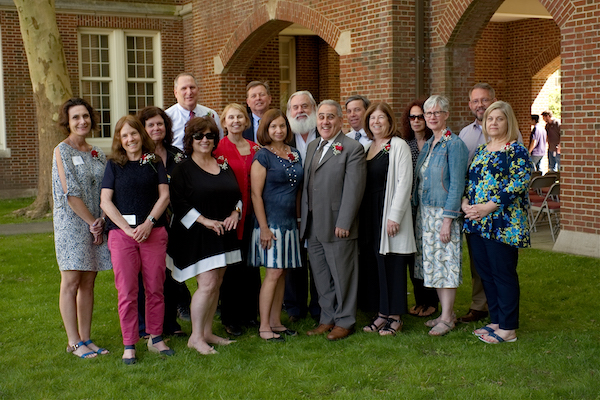 It was an evening of goodbyes and helloes at the Scarsdale School Board on June 11, when the Board recognized the retirement of some longtime staffers and formerly hired many new faculty members as well.
It was an evening of goodbyes and helloes at the Scarsdale School Board on June 11, when the Board recognized the retirement of some longtime staffers and formerly hired many new faculty members as well.
June 11, 2019 also marked the final meeting for the 2019-2020 Scarsdale Board of Education and three retiring Board members, Nina Cannon, Lee Maude and Bill Natbony were recognized for their service.
Recognizing the retiring faculty, Dr. Hagerman quoted Parker J. Palmer and said, “I am a teacher at heart, and there are moments in the classroom when I can hardly hold the joy. When my students and I discover uncharted territory to explore, when the pathway out of a thicket opens up before us, when our experience is illumined by the lightning-life of the mind—then teaching is the finest work I know. He thanked them for “informing a generation that will shape our future” and said, “You have been leaders, trusted companions and collaborators ... You have demonstrated what it means to be the gest of Scarsdale educators.”
Among the retirees who attended the evening meeting were:
Larry Chatzinoff, Assistant Principal at Scarsdale Middle School
Cheryl Higgins, Second grade teacher at Heathcote Elementary School
Dr. Scott Houseknecht, Principal at Edgewood Elementary School
Lisa Onofri, Second grade teacher at Heathcote Elementary School
Marjorie Ross, Eigth Grade English Teacher, Scarsdale Middle School
Dr. Craig Sherman: District Coordinator of Music and Performing Arts and High School Department Chair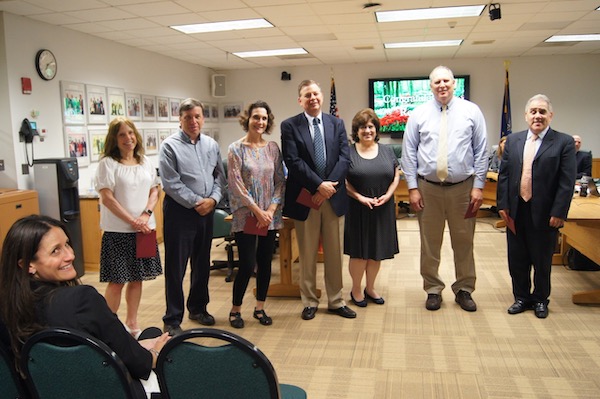
Several others also retired and all were recognized at an afternoon reception. Pictured at top from left to right are: Lisa Onofri, Marjorie Ross, Barbara Vogel, Larry Chatzinoff, Cheryl Higgins, Elizabeth Ungar, Dr. Scott Houseknecht, Linda Rich, Steve Bogardus, Dr. Craig Sherman, Steve Rambone, Beth Kaye, Faye Turitz, Katherine Krahl, Dr. Thomas Hagerman, Karen Lucente. (Photo credit Scarsdale Schools)
Assistant Superintendent Drew Patrick also announced many new hires and promotions. Trisha Iasiello who is currently a second grade teacher at Fox Meadow School was approved for an appointment as Assistant Principal at Fox Meadow School. She holds a M.A. in Special Education from Mount Saint Mary College, and a B.S. in Elementary Education from Clemson.
Speaking to the retiring Board members, Board President Scott Silberfein thanked them for their dedication and service and for exemplifying “non-sibi.” He noted that the Board had done significant work on the 2018 bond project, safety and security and reviewing board policies.
Dr. Hagerman said, “What feels like an end is often a beginning. We are finishing one year while planning for another.” He thanked Bill, Lee and Nina for “dedicating years of their lives to our schools and our students,” and listed some highlights of the year including the hiring of new teachers and administrators, an 80% approval rate on the 2019-20 school budget, the implementation of Scarsdale’s first food service plan for all elementary schools, consideration of safety and security, the proposal regarding lights at Butler Field and a comprehensive review of school policies.
Bill Natbony made lengthy comments are included below.
Nina Cannon said, “It has been my absolute pleasure to serve… I have learned and benefited and have tremendous respect for each of you.” She said, I have had “meaningful engagement with so many teachers and community members,” and thanked the SBNC for supporting her candidacy.
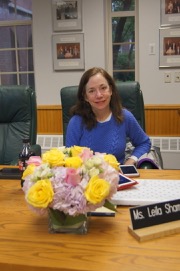 Lee Maude completed six years of service on the Board of Education.Lee Maude said, “It’s been an incredible six years.” Turning to Dr. Hagerman she said, “I went to Winnetka with Mr. Wixted and met you and got a sense of who you were. I watched you do your entry plan, transition, bond, budgets … I watched you take it in and see how Scarsdale was like Winnetka – but not. You hired and put together your cabinet. You set up a process. We were always moving forward. The learning commons and maker space is here and make our curriculum so much richer.”
Lee Maude completed six years of service on the Board of Education.Lee Maude said, “It’s been an incredible six years.” Turning to Dr. Hagerman she said, “I went to Winnetka with Mr. Wixted and met you and got a sense of who you were. I watched you do your entry plan, transition, bond, budgets … I watched you take it in and see how Scarsdale was like Winnetka – but not. You hired and put together your cabinet. You set up a process. We were always moving forward. The learning commons and maker space is here and make our curriculum so much richer.”
Later in the Personnel Report, Assistant Superintendent Drew Patrick announced the hiring of many new faculty members.
Below please find comments from Board Member Bill Natbony as well as the League of Women Voters of Scarsdale and the Scarsdale PT Council.
From Bill Natbony: We have a long agenda this evening but I could not let my last public meeting as a School Board member pass without a few brief remarks and thank yous.
Six years ago, and again 3 years ago, the SBNC and our Scarsdale community allowed me the incredible opportunity to serve as a member of this Board of Education. It has been an opportunity and experience I have greatly appreciated and am thankful to have had this chance to serve. This Board stands as a true example of the importance and vitality of volunteerism in Scarsdale and I urge those of you who have not yet caught the Scarsdale volunteerism fever to do so.
When I first joined the Board, I did so with two fervent hopes and desires -- first, to assist the Board 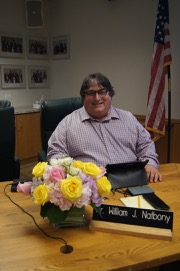 Bill Natbony served two terms on the Board.and Administration in preserving our school system -- a source of immense pride to both past and present residents, and an attraction for future residents. Second, the hope was to enhance our system through creativity and necessity.
Bill Natbony served two terms on the Board.and Administration in preserving our school system -- a source of immense pride to both past and present residents, and an attraction for future residents. Second, the hope was to enhance our system through creativity and necessity.
The last six years have brought significant positive change to our schools in many ways and in many areas -- curriculum (including STEAM and other areas), facilities, special education, communication, wellness, sustainability, labor relations and budgeting just to name a few. I am proud of the various Board compositions over these years and of what we accomplished together with the Administration.
As a Scarsdale resident looking at public meetings, news reporting, communications and community buzz, one often still sees the Board and Administration through the lens of a single issue that might be of interest to you. It is difficult to see and understand the vast number of issues and, events, actions, policies and decisions that are considered and implemented. This is hard but gratifying work and the main recipients of all this work are our children.
These are tasks that no one person, or one group of people can accomplish with positive results. They require thought, debate, compromise, research and listening. I cannot imagine having a better group of partners these last six years.
First, I would like to thank my fellow Board members (past and present) for their insight and for their ears. It has been and honor and pleasure to work with you. I would like to particularly thank Lee and Scott who served with me at times when I was a Board officer. Thanks for both teaching me and learning with me.
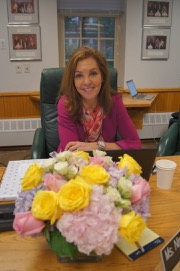 Nina Cannon at the final board meeting.Second, I would like to thank the School Administration, both past and present, and in particular our School Superintendent Thomas Hagerman. We essentially grew up together as you started your new term as Lee and I were joining the Board. Thank you for your passion, your vision and your ability and desire to care about doing what's right every day. You have led this District with great distinction and I look forward to seeing continued great leadership in the future, though perhaps from a little further afar. I must also note that you have assembled a truly "all star" leadership group around you with remarkable talent and insight and I thank your cabinet members for the honor to have worked with them over the years.
Nina Cannon at the final board meeting.Second, I would like to thank the School Administration, both past and present, and in particular our School Superintendent Thomas Hagerman. We essentially grew up together as you started your new term as Lee and I were joining the Board. Thank you for your passion, your vision and your ability and desire to care about doing what's right every day. You have led this District with great distinction and I look forward to seeing continued great leadership in the future, though perhaps from a little further afar. I must also note that you have assembled a truly "all star" leadership group around you with remarkable talent and insight and I thank your cabinet members for the honor to have worked with them over the years.
Third, I would like to thank the community and community groups not only for giving me the chance to sit at this table, but also for giving me comments to think about and a level of community involvement that is unmatched. This community is demanding and rightly so. Remember that this Board and the Administration share the same goals for our school system. Some decisions are harder than others, but from experience I can tell you that the Board and Administration always seek the right answers after appropriate debate and listen not only to you but to each other. We operate on the assumption that all are acting in good faith with appropriate motives. That is an important basis for a working partnership. I have enjoyed that partnership.
There are so many other groups to thank -- the teachers who keep our schools buzzing with intellectual curiously and creativity all hours of the day, and other staff that keep our schools safe and operating efficiently. Thank you for allowing me to join you in our common quest.
Finally, a thank you to my family who has suffered (or maybe cheered) my absence from home on many mornings, days and evenings. I know it was hard for you but the end result for our community is one that is vitally important and I thank you for allowing me to pursue my passion about education.
Speaking on behalf of the League of Women Voters of Scarsdale, President Leah Dembitzer said, “The League Board wishes to thank outgoing Board of Education members, Bill Natbony, Lee Maude and Nina Cannon for their years of dedicated service to our phenomenal school district. Bill and Lee, you have both served on the board for six years, and have both served as president of the board. Your leadership, determination, attention to detail and preparation for meetings has been extensive and tireless. Bill, your letters to the community, to further engage and connect with the community, were thoughtfully executed and beneficial. Lee, your commitment, year after year, to striking the right balance between the value of a Scarsdale education with a keen awareness of the tax burden, demonstrated your constant cognizance that your service required difficult and thoughtful decisions. Nina, during your three years on the Board, your attention to detail, astute and nuanced questions, connection and engagement with community groups, and thoughtful stewardship have brought much to the community at large.
Bill, Lee and Nina, the League Board deeply appreciates all of your dedicated work to protect and enhance a Scarsdale education for our community’s children and we wish you all the best in your future endeavors.
PT Council Chair Amber Yusuf offered the following comments: On behalf of PT Council, I extend a heartfelt thank you to all the retirees who were recognized earlier this evening and wish them well in their next adventures. And to mark the final board meeting of the school year, I also wish to thank Board President Scott Silberfein, Vice President Pam Feuhrer, who also served her second year as board liaison to PTC, all members of the Board of Education, Dr. Thomas Hagerman, and the entire cabinet for your dedicated service and commitment to our children’s education. The PTC looks forward to continued collaboration with you next year.
Last month, at our annual PTC luncheon, we paid tribute to retirees Scott Houseknecht and Larry Chatzinoff. Dr. Housknecht had the honor of serving as principal at the Edgewood School for 29 years and presiding over their centennial celebration. Scarsdale Middle School was fortunate to have Mr. Chatzinoff’s thoughtful and hard-working presence for 19 years. In their honor, PT Council has made a generous donation to the SHS PTA Scholarship Fund to help students as they start their first year of post-secondary education.
I have the honor tonight of also recognizing the three outgoing members of the Board of Education as they complete their board service. Nina Canon joined the board of education three years ago, and from the start, your pleasant demeanor built a solid foundation for trust. You took your role seriously, respectfully challenging the administration and fully understanding management. You are an outstanding editor with a remarkable eye for detail. You often came to the board table open to ideas, with a willingness to listen to and learn from others, allowing you to be flexible in your decision-making. Your persistence and confidence was present when needed, but always with a smile. You looked for efficiency, efficacy and facility during your tenure, and these characteristics will be missed. Most importantly, you kept our children’s needs first and foremost, and we appreciate your service Nina.
Bill Nabotny, as you complete your second term, I wish to thank you for your service over the years as a deeply thoughtful board member who was guided by a belief in doing what was fair and just. Your appreciation of the other Board members suggestions was noted, and you worked to adjust your opinion based on the input of your fellow board members and community perspectives. Your ability to play Devils’ advocate ensured that both sides of every issue were fully considered. Your curious and communicative nature served you well during your term as Board President. And your through consideration of issues helped pace the Board so that the big picture and long term impact were always considered. Your commitment to fiscal responsibility served our community well during two bond efforts during your time on the Board. Bill, your mindfulness around the impact to students will always be appreciated.
And last but most certainly not least, thank you Lee Maude for your leadership over the past six years, serving two terms as Board President starting in the third year of your first term. We are lucky to have had your strength and tenacity during challenging times in our community, guiding the Board and the administration through a time of exceptional challenges with both contracts and bond proposals. Your commitment to community engagement and participation is exemplary, and you ensured the administration attended to all input and concerns. You were instrumental in building a better board, by establishing an atmosphere of respect and trust, fostering dialogue and effective questioning. You took the time to research best practices, attend workshops and consult with other Board Presidents, always putting in extra effort. Lee your commitment to all of our students, in addition to those with needs, will be missed.
A sincere thanks to all of you for efforts and time you spend for the well-being of our children and the betterment of our community.
SHS Counseling Director Provides Perspective on Granting Students Extra Time on College Admissions Test
- Details
- Written by: Joanne Wallenstein
- Hits: 9344
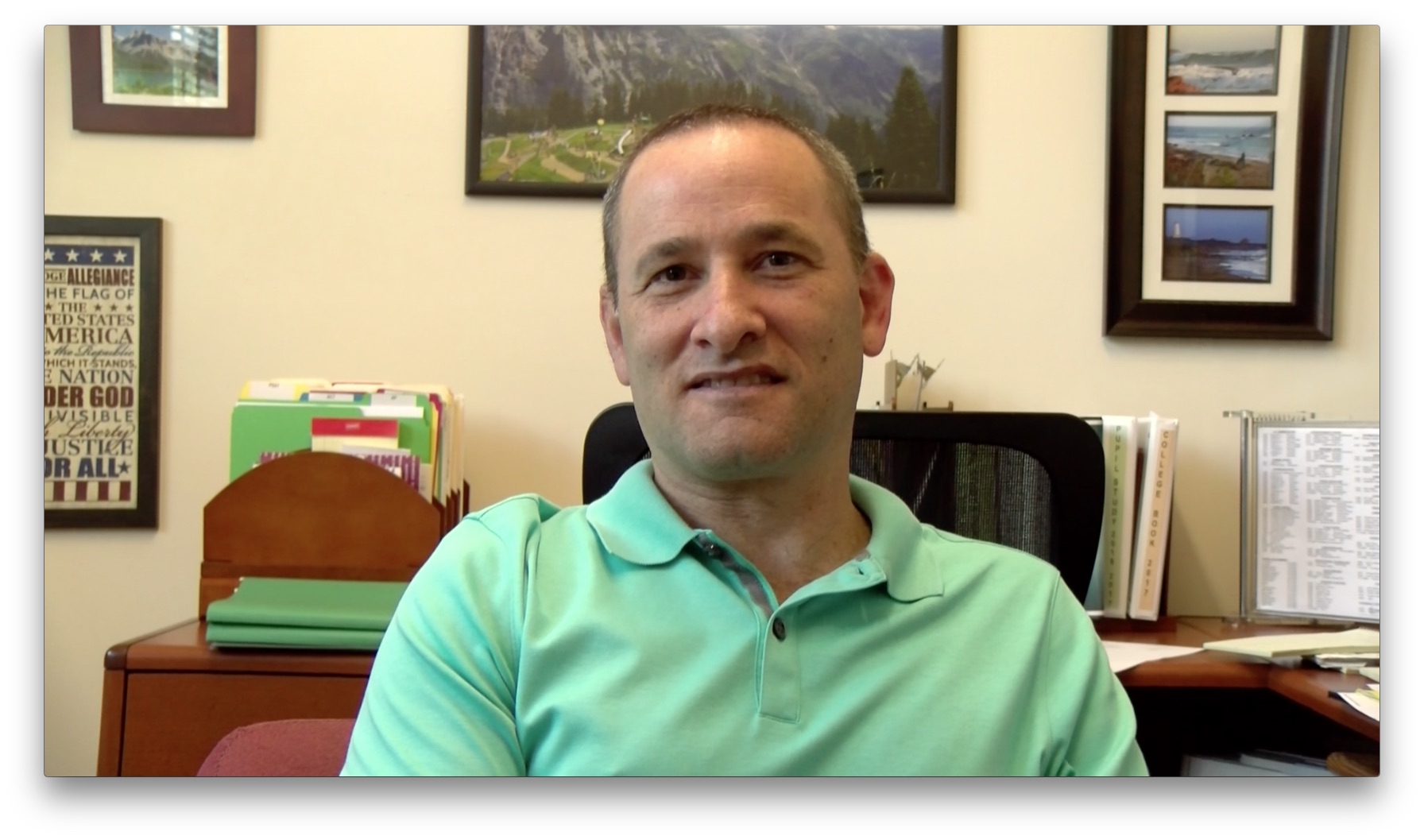 Director of Counseling Oren Iosepovici Several readers noted a news item showing that the number of public high-school students getting special allowances for test-taking has risen sharply in recent years. They spotted an article that said that 20% of students at Scarsdale High School are eligible for extra time or another accommodation when taking the SAT or ACT tests.
Director of Counseling Oren Iosepovici Several readers noted a news item showing that the number of public high-school students getting special allowances for test-taking has risen sharply in recent years. They spotted an article that said that 20% of students at Scarsdale High School are eligible for extra time or another accommodation when taking the SAT or ACT tests.
The data came from an analysis in the Wall Street Journal of 504 designations at 9,000 public schools.
We asked Scarsdale High School’s Director of Counseling Oren Iosepovici to provide some perspective on this statistic. Specifically we wanted to know if 20% was high? … if the percentage was growing and if it is higher than the overall percentage of students who are classified or receive special services from the district?
Commenting for the district, here is Iosepovici's response:
On any given year, 10-13% of students qualify for special education services. This is consistent with the national average.
Another 8-10% qualify for 504 accommodations for documented impairments such as anxiety, depression, or the like. These numbers are also consistent with national averages. Scarsdale acknowledges these issues and provides accommodations as we believe this is the right way to support children with unique needs. What the article doesn’t say is that many other districts do not. The numbers aren’t different across schools across the country. But services cost money. In many places, parents have to fight to have their students classified because they don’t want to pay for accommodations.
Many school districts won’t provide 504's at all. We believe students with needs should be supported to the extent possible. Rather than comparing us to this norm of not supporting students and families, we believe students should be supported across the state and country in the way that Scarsdale does for our students who need that help—in the short or long term. Many school districts do not have the resources to do so, but I would hope if they did, everyone would use Scarsdale as a model of providing wrap around services to students who need them.
All the best,
Oren Iosepovici
Director of Counseling
Scarsdale High School
SHS Juniors Get the Tea on College from Returning College Freshmen
- Details
- Written by: Jamie Robelen
- Hits: 4093
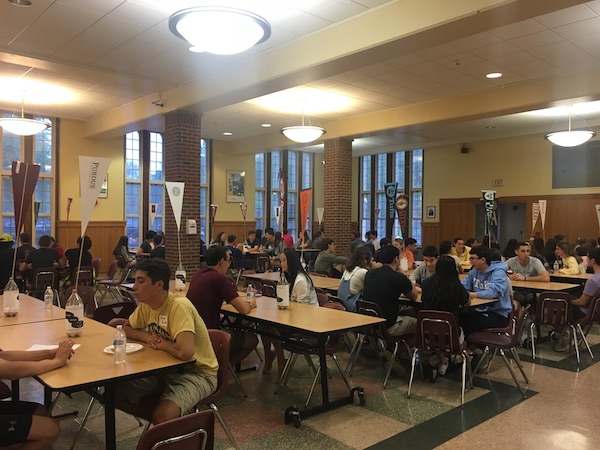
One such offering is the annual student-to-student college night, which this year was held on Wednesday, May 22. Scarsdale alums who have just completed their freshman or sophomore year of college were invited to come back to the high school cafeteria for a night and talk to juniors. It is a one-on-one experience, with an emphasis that there are no parents allowed. Beforehand, students are given a list of which representatives will be in attendance and each junior selects a few colleges in which they might be interested. In an evening that resembles speed dating, they are assigned to speak to representatives from four schools for 15 minutes each.
What’s great about the student-to-student night is how personal it is. Although some schools may be more popular than others, for the most part it is usually just one junior talking to one college kid. Typically, the conversations lean towards more what it’s like to be at the school, rather than the academic information or school stats that someone might learn from an information session on a college tour. Many talk about housing. Another common topic is social life, something that most schools don’t really offer insight into on a campus tour. Juniors can find out the real scoop on whether schools are “party schools” or not, if Greek Life dominates campus culture, or what kids do for fun on weekends.
Unfortunately, not every school can be represented, since a few schools are still in session. However, even if students don’t speak with students at four schools they love, the night can still be helpful. Juniors can get a “vibe” for a few different of schools, and start thinking about where they would most fit in.
The PTA encourages all SHS alums ending their first or second year of school to participate, so that students can get a real feel for places that have made Scarsdale kids happy.










